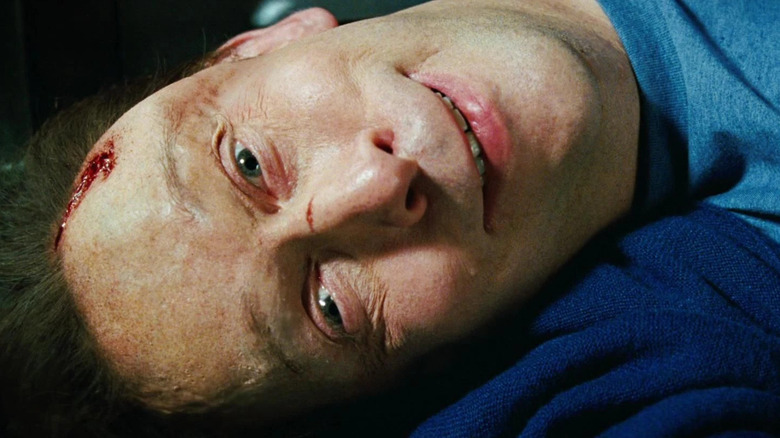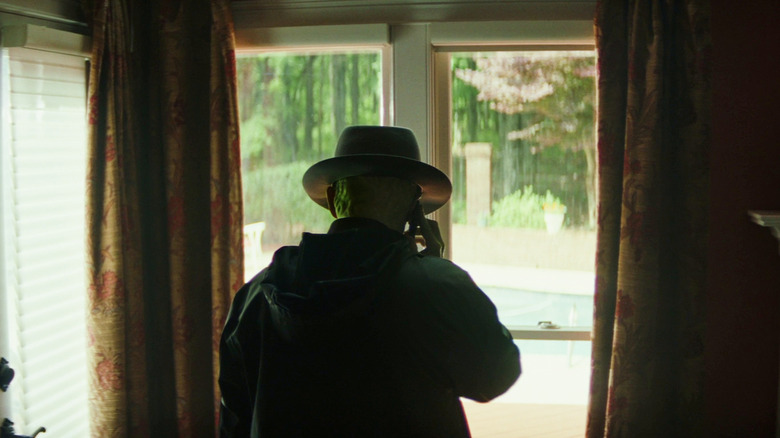Captain America: Brave New World's Villains Couldn't Be More Confusing If They Tried
Spoilers for "Captain America: Brave New World" follow.
"Captain America: Brave New World" has, rather than opening up such a world for Marvel Studios, only become another reminder audiences are falling out of love with their movies. (Read /Film's unimpressed review here.)
The production of "Brave New World" has has been described as "chaotic." The movie went through multiple reshoots, and watching the movie you can see the unsightly seams of drafts stitched together. The primary villain, Dr. Samuel Sterns/The Leader (Tim Blake Nelson), is always a dozen steps ahead of the heroes, but his plan is there to serve the script and get it to the set-pieces, not the other way around.
When we last saw Sterns in "The Incredible Hulk," he was helping Bruce Banner (Edward Norton) create a cure for the Hulk. Sterns, though, also wanted to use Banner's Hulk blood for medical research purposes. Aging soldier Emil Blonsky (Tim Roth), envious of the Hulk's power, made Sterns turn him into the Abomination. Sterns was later implied to be getting some superpowers of his own when some of Banner's gamma-irradiated blood to dripped into his open head wound. When "The Incredible Hulk" was made, the intent was probably for Sterns to return as the Leader in a proper sequel (one that wouldn't have taken 17 years to come out). But the movie got an unenthusiastic reception and that, coupled with a complicated rights tie-up over the Hulk with Universal Pictures, meant that Marvel Studios never made another solo Hulk movie.
"Brave New World" finally checks back in on Sterns, who did indeed mutate from the Hulk blood, gaining super-intelligence and a deformed appearance (green skin and an engorged brain). General Thaddeus Ross (Harrison Ford) had Sterns imprisoned in a West Virginia black site to take advantage of his intelligence. Sterns designed pills to improve Ross' failing heart and, by using his power to calculate probabilities, guided Ross to the presidency. But Ross didn't give Sterns his promised pardon, so to repay 16 years in a cage, he decides to destroy Ross' legacy.
But here's the problem: this all happened offscreen, so the movie is stuck telling you, not showing. Then again, with how haphazard Sterns' plan is, maybe more telling wouldn't have been a bad call.
What does the Leader want in Captain America: Brave New World?
After realizing Ross wouldn't release him, Sterns put his revenge plan into effect. He'd developed mind control technology, and disseminated it throughout the U.S. military so as to use soldiers as tools in his plot. How does the tech work? I'm not totally sure, nor do I think the film itself is, but the trigger song is "Mr. Blue" by the Fleetwoods. (Mr. Blue was Sterns' pen-pal alias with Bruce Banner.)
Sterns' plan begins. Ross' goal for his first 100 days is to sign an international treaty ensuring equal distribution of adamantium, discovered in and harvested from dead Celestial Tiamut. (See: "The Eternals.") So, disrupting that plan is how Sterns attacks. He hires criminal gang the Serpent Society, led by Sidewinder (Giancarlo Esposito), to steal the only adamantium sample in the world from Japan.
His plan is two-pronged. For one, he pays the Serpents with money from a CIA fund, making it look like the U.S. stole the adamantium in order to destabilize relations between America and Japan. Second, Sterns predicted that Ross would send Captain America (Anthony Mackie) to recover the adamantium, that Ross then would invite Sam to the White House for the treaty negotiation, and that Sam would invite Isaiah Bradley, whom Sterns then mind controlled to shoot at (but not kill) Ross. Tensions would then escalate between the U.S. and Japan until they'd spiral into a naval war. Ross can't tell Japan the truth because the truth about Sterns implicates him, but he would lead from the frontline like the soldier he is.
The stress of the situation (egged on by a phone call from Sterns) would make Ross flip out into the Red Hulk, triggered by samples of gamma radiation Sterns progressively added to Ross' heart pills. Cap intervenes and stops the war, so Sterns turns himself in and leaks the truth to the press. Ross, confronted by his actions, turns into the Red Hulk in the middle of Washington D.C. and leaves a mess behind. So, while the Leader lost his freedom, he succeeded in destroying Ross' legacy. Ross resigns the presidency and is imprisoned in the Raft.
Captain America: Brave New World commits a storytelling cheat
If this all sounds like it hinges on coincidence and luck that each piece moves in the proper direction, that's because it does! But the movie brushes that aside by talking up the Leader's intelligence, saying he can calculate probability and outcomes even better than high-functioning algorithms. He is, in effect, clairvoyant — able to see possible futures far in advance and always have back-up plans for unlikely outcomes.
But this is a screenwriting cheat with circular logic. The sequence of events is supposed to makes sense because the Leader, the smartest person in the world, knew how to fit the puzzle pieces together. But the Leader is also a fictional character, under the control of the screenwriters who are in charge of mapping the narrative. Instead of writing a strong story, they wrote a weak one with a flimsy justification. The obvious comparison is to Lex Luthor (Jesse Eisenberg) in "Batman V Superman," who runs a similar hairbrained scheme (culminating in the release of a giant mutant monster) that the movie unconvincingly sells as the work of a mastermind.
If you walked away from "Captain America: Brave New World" feeling confused by the Leader's characterization, that's because the movie just doesn't make his revenge palpable enough, or his intelligence credible enough, for it to convince audiences.
"Captain America: Brave New World" is playing in theaters.


